So the good news is, Google Ads works. When your business appears for specific, high-intent searches your potential customers are performing, you can expect high returns.
The bad news is, everyone’s using it, and since the Google Ads platform runs as an auction, the more businesses advertising on it, the more expensive it can get.
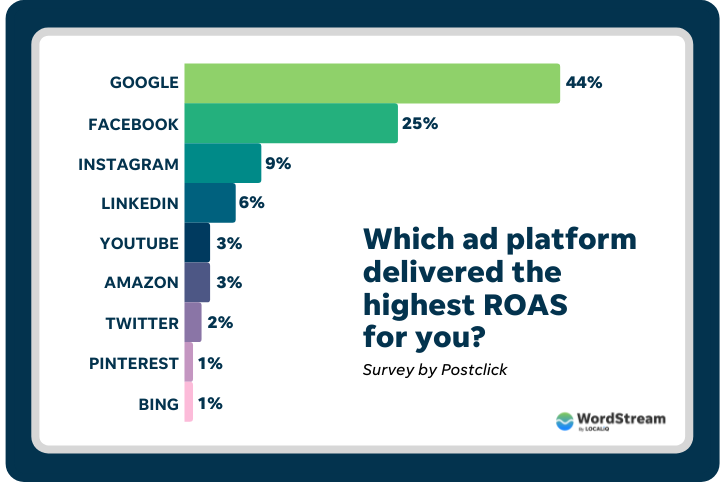
The great news? There are a number of small details you can take care of to find profitable customers in cost-effective ways. You just have to be smarter than the average bear to do so.
That’s what I’m here for. In this post, I’m going to show you how to save money in Google Ads by:
- Spending only on the right users
- Standing out from competitors
- Improving your landing pages
Only spend on the right users
The first area we need to focus on is making sure we’re not reaching beyond our means. That is, that we’re spending our budget only on audiences with the highest likelihood to convert.
1. Use location targeting
When you create a new campaign in Google Ads, the location targeting nearly always defaults to the country you’re in, but every once in a while, it will actually default to “All locations,” meaning—you guessed it—everywhere in the world.
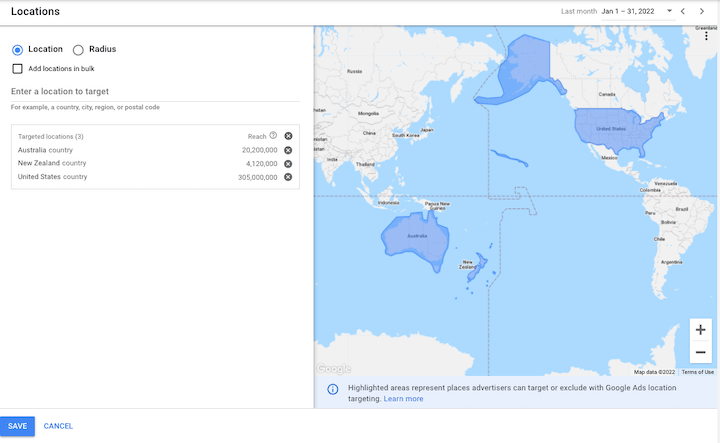
It makes zero sense to advertise to people who you cannot service or would be unprofitable for you. Google Ads offers highly customizable location targeting options you can use to include the best locations for you and exclude those that will be a waste of budget.
Pro tip: Although many folks love the idea of zip codes, they can be hard for the ad platforms to actually determine. If possible, try to use city or neighborhood targeting in lieu of zip code targeting to have a little better reach.
Additionally, make sure you have your advanced targeting settings selected to only “Those in my area” as opposed to “Interested in my area”. This might not have a massive impact, but no incremental win shall go un-won, or something like that.
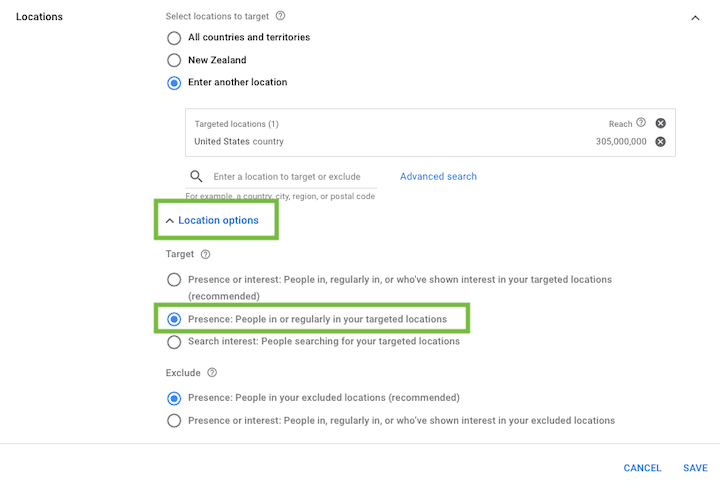
2. Bid on high(er) intent keywords
Many times I log into new accounts where people aren’t seeing the results they want and the keywords are alarmingly broad. (And by broad, I don’t mean the match type. We’ll get to that in a minute.)
Let’s take an example: shoes. If your business is trying to sell shoes to people, godspeed. But in all seriousness, the shoe space is very crowded, so ensuring you’re advertising for exactly the right things is critical.
Let’s say you’re a specialty shoe store and you’ve chosen to only sell women’s golf shoes (interesting choice, but ok). Here is a list of keywords that could technically qualify for you, but….it’s not nearly as specific as it could be.

This list is a lot more qualified. For these, you’ll be getting search traffic and clicks from people who are looking for exactly what you sell.

These specific keywords will of course have far lower search volume than the broader list above, but we’re not in this for the volume of search terms. We’re in it for sales.
If you have a limited budget, focus only on those things you actually sell and stay away from the higher volume keywords that will drive up your spend and likely yield less qualified traffic. You can learn more in our Big, Easy Guide to Keyword Research.
3. Use only phrase and exact match keywords
Keyword match types have been getting less and less specific over the last half-decade, but that doesn’t mean you shouldn’t work to keep the user queries you match to as specific as possible. For the purposes of this post, I encourage you to focus only on Phrase and Exact match keywords for your campaigns.
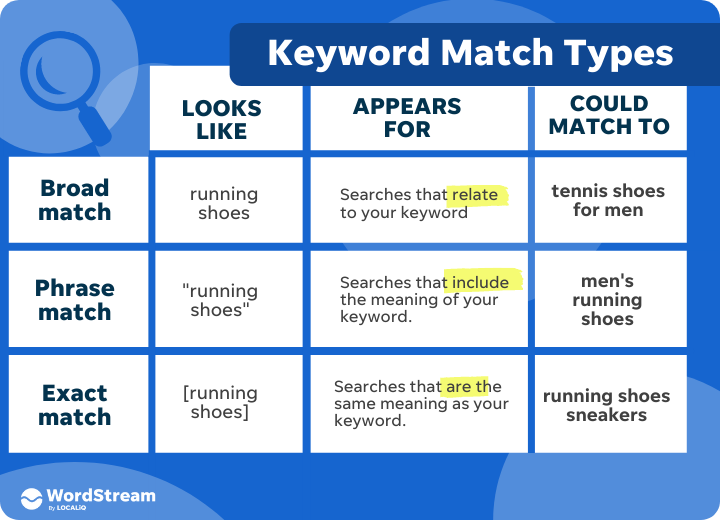
Despite many of Google’s claims about broad match being more effective these days, the higher quality, better-matched queries are going to come from using the more limited match types. This will help you limit your coverage on lower-quality searches by unqualified users that broad match can rustle up and burn your budget.
Are you wasting money in Google Ads? Find out with the Free Google Ads Performance Grader.
Stand out from the competition
When you’re trying to be frugal in Google Ads, specifically when you’re competing against big brands, it’s important to make sure you stand out from the competition. There are a few simple ways to do this.
4. Use all the ad extensions
If I conduct a quick search for “small business CRM,” nearly all the ads look the same if you look at just the text. But the one that stands out and gets your attention? That’s the monday.com ad that has the image extension.
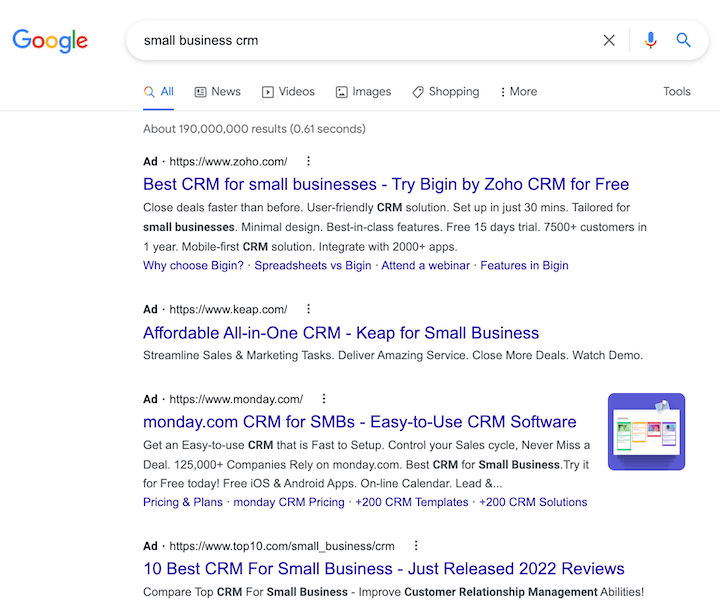
The image extension clearly helps the monday.com ad stand out from the rest. There’s this little block of color where all other ads are really just text. While this doesn’t mean that those companies aren’t using image extensions, it does mean that, for whatever reason, on this search monday.com has the attention advantage.
For this reason, I encourage you to always use every iteration of ad extensions that you’re eligible to use.
- Sitelink
- Callout
- Structured snippet
- Image (how to set up image extensions here)
- Call
- Lead form
- Location
- Affiliate
- Price
- App
- Promotion
When you’re in the Google Ads interface, click on Ads on the left navigation, then Ad Extensions.
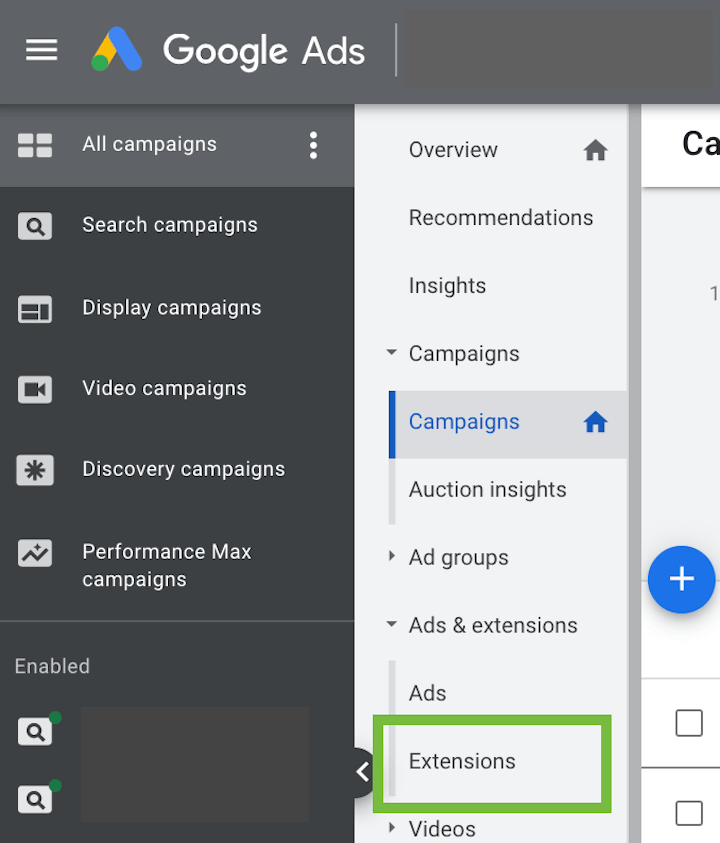
Once you’re on that page, click the blue plus button to add any of the extension types listed. By having as many extensions as possible, you’re giving yourself the best chance to capture the user’s attention on the SERP and stand out from the competition.
5. Use Auction Insights for your messaging
Not every search is going yield ads with lots of extensions included. In that scenario, you’re left to your Google ad copy and messaging to help you stand out from the competition.
The first step is to identify who your competition is. If you already have campaigns running, you can use the Auction Insights report to identify the other companies that are showing up next to your ads. (Side note: if you review this list and think to yourself, “these aren’t my competitors,” you likely need to revisit your keyword list!)
In the Google Ads interface, click on Keywords on the left-hand navigation, then choose Auction Insights down at the bottom.

Once you’re there, you’ll see a report that looks like this. It lists the companies that are showing up next to your ads, then gives you a number of stats to help you understand how you stack up to their coverage. (You can learn more about the Auction Insights report in this video.)

Once you know who you’re competing against, you can use competitive keyword research tools like iSpionage to find out what they’re using in their ad copy and how you can separate yourself.
If you’re not able to get the software, the easiest way to find out what people are using in their ads is to simply conduct searches on your keywords.
Pro tip: This suggestion comes with a HUGE word of caution. If you do this regularly and don’t click on your ads, or any others, you’re going to indicate to Google you’re not actually in the market for your offerings. Meaning that over time, you won’t see ads for yourself or others. So IF you do conduct searches to get insights, I suggest you do them very minimally and try to use different devices for each subsequent search to prevent Google from inferring patterns from your behavior.
Once you have a good handle on what other competitors are doing, whether through tools or through SERP spying, make sure your ads stand out.
- If every ad uses the keyword (or something close to it) in Headline 1, then you’re likely best served to not do that. (Google Ads headline examples here!)
- If all businesses are offering a discount, it may make sense for you to speak to your higher level of quality, explaining why you don’t have a discount.
- If your competitor’s listed price is higher than yours, list your price and taut how you’re “cheaper than the other guy.”
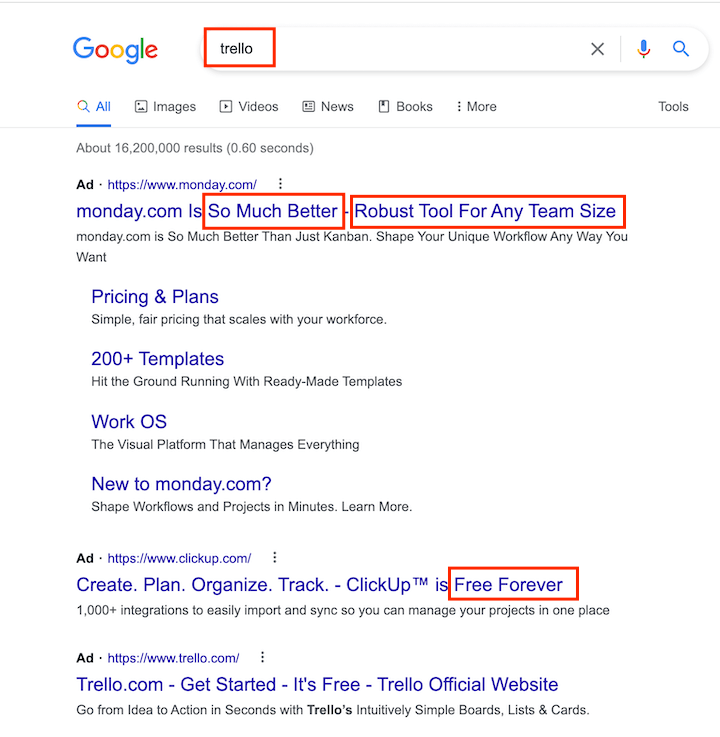
The key on the SERPs is to stand out. So based on what you find, make sure that you’re able to craft a new message and be the brand that stands out.
Take special care with your landing pages
You’ve spent your time and hard-earned money developing Google Ads campaigns to bring users to your site, but take a good, honest look at your landing pages. Would you convert on them? Be honest. If you’re lying to me, it’s not hurting me. It’s only hurting you!
6. Have quality landing pages
Higher quality landing pages mean higher Quality Scores, which means lower cost per click. And while landing pages used to be a big pain in the butt, they no longer have to be. Platforms like Unbounce and Instapage make creating landing pages easy for anyone, including people who aren’t coders or developers (i.e., the author of this post).
Here are a few specifics to keep in mind for high converting landing pages:
- Always have a clear call to action that is being tracked through conversion tracking.
- Be sure the content on the page puts your product or service in a good light and convinces the user to work with you.
- Ensure the page loads quickly on both a desktop and a mobile device. If you’re not sure about how to improve page speed, run your landing page through the Google PageSpeed Insights tool.

Attractive, organized, clear CTA—nice landing page.
Remember, the landing page is the closer to the conversion deal. If you haven’t set yourself up well, it doesn’t matter what you did well in the campaign setup and strategy portion of the process.
7. Be strategic with conversion goals
Ideally you’ve targeted the right people, stood out from the competition, and brought someone to an impressive landing page that loaded amazingly fast. But is your conversion action what the customer is ready to do? Have you thought through your conversion action thoroughly? Do you offer them any other option other than a final sale?
If the answer to any of those questions is no, you might want to think about adding a secondary, softer call to action on the landing page.
- Are you asking someone to buy something? Maybe also offer an email signup for your newsletter to hear about sales and promos.
- Asking for someone’s information to put together a custom quote? Maybe also create an easy calculator to help them develop an estimate on their own.
Each of these actions, while not necessarily being the conversion goal you may want in the end, will help capture additional users who weren’t ready to convert on your key action in that moment.
It’s a small consolation prize, but if you’re able to capture some of that user’s information, you’ll be able to use it as part of your first-party data set to retarget them across any ad platform and reengage with them, hopefully convincing them to take the desired action you want.
Start saving money in Google Ads now
The way Google Ads works gives advertisers with any budget the ability to yield a strong ROI—making it one of the best digital advertising platforms out there. But you have to know how to use it to enjoy it. These seven strategies will help you to save money and get the most out of your budget:
- Narrow down your location targeting
- Target high(er) intent keywords
- Use only phrase and exact match keywords
- Ad extensions: use ’em!
- Differentiate your messaging
- Don’t skimp on landing pages
- Be strategic with conversion goals
The post 7 Pro Tips to Save Money (and Compete!) in Google Ads appeared first on WordStream.




Recent Comments